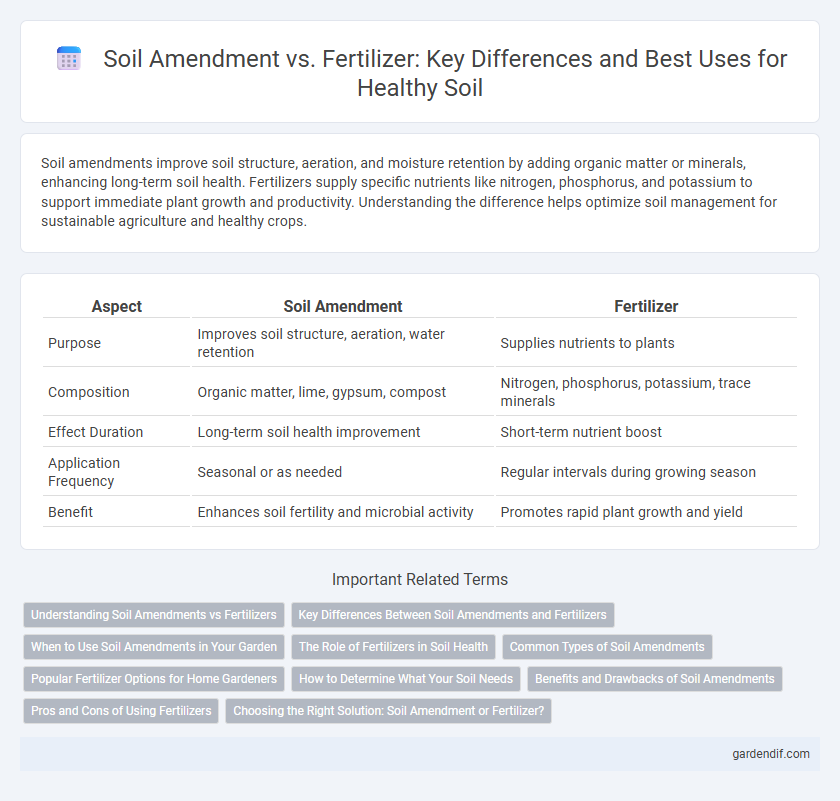
Soil amendment vs Fertilizer Illustration
Soil amendments improve soil structure, aeration, and moisture retention by adding organic matter or minerals, enhancing long-term soil health. Fertilizers supply specific nutrients like nitrogen, phosphorus, and potassium to support immediate plant growth and productivity. Understanding the difference helps optimize soil management for sustainable agriculture and healthy crops.
Table of Comparison
| Aspect | Soil Amendment | Fertilizer |
|---|---|---|
| Purpose | Improves soil structure, aeration, water retention | Supplies nutrients to plants |
| Composition | Organic matter, lime, gypsum, compost | Nitrogen, phosphorus, potassium, trace minerals |
| Effect Duration | Long-term soil health improvement | Short-term nutrient boost |
| Application Frequency | Seasonal or as needed | Regular intervals during growing season |
| Benefit | Enhances soil fertility and microbial activity | Promotes rapid plant growth and yield |
Understanding Soil Amendments vs Fertilizers
Soil amendments improve soil structure, water retention, and aeration by adding organic matter or minerals, enhancing the overall soil health and creating a better environment for plant roots. Fertilizers supply essential nutrients like nitrogen, phosphorus, and potassium directly to plants, promoting specific growth and crop yield. Understanding the distinction helps optimize soil management practices for sustainable agriculture and long-term productivity.
Key Differences Between Soil Amendments and Fertilizers
Soil amendments improve the physical properties of soil, such as texture, moisture retention, and aeration, enhancing overall soil health without necessarily adding nutrients. Fertilizers provide specific essential nutrients like nitrogen, phosphorus, and potassium directly to plants to promote growth and increase yields. Unlike fertilizers, soil amendments have a longer-term effect on soil structure, while fertilizers offer immediate nutrient availability for plant uptake.
When to Use Soil Amendments in Your Garden
Soil amendments improve soil structure, enhance water retention, and increase organic matter, making them essential when planting new gardens or correcting poor soil conditions. Use soil amendments before planting to create a healthy, balanced environment that supports root development and microbial activity. Fertilizers, on the other hand, supply specific nutrients and are best applied during the growing season to address nutrient deficiencies.
The Role of Fertilizers in Soil Health
Fertilizers play a crucial role in replenishing essential nutrients like nitrogen, phosphorus, and potassium, directly enhancing soil fertility and plant growth. Unlike soil amendments that primarily improve soil structure and moisture retention, fertilizers provide targeted nutrient supplementation to support crop productivity. Proper application of fertilizers helps maintain nutrient balance, promoting healthy microbial activity and long-term soil health.
Common Types of Soil Amendments
Common types of soil amendments include organic matter such as compost, manure, and peat moss, which improve soil structure and water retention. Inorganic amendments like lime and sulfur adjust soil pH to enhance nutrient availability. Other amendments, such as gypsum, help improve soil aeration and reduce compaction, distinguishing them from fertilizers that primarily supply specific nutrients to plants.
Popular Fertilizer Options for Home Gardeners
Popular fertilizer options for home gardeners include organic choices such as compost, manure, and bone meal, which enrich soil nutrients naturally. Synthetic fertilizers like nitrogen-phosphorus-potassium (NPK) blends provide targeted nutrient boosts for plants. Soil amendments, in contrast, primarily improve soil structure and water retention without directly supplying essential plant nutrients.
How to Determine What Your Soil Needs
Evaluating soil needs begins with conducting a comprehensive soil test to measure pH, nutrient levels, and organic matter content. Soil amendments improve soil structure, water retention, and pH balance without necessarily adding nutrients, while fertilizers supply essential macro and micronutrients like nitrogen, phosphorus, and potassium. Interpreting soil test results helps determine if the soil requires amendments to enhance physical properties or fertilizers to correct nutrient deficiencies for optimal plant growth.
Benefits and Drawbacks of Soil Amendments
Soil amendments improve soil structure, water retention, and aeration, enhancing long-term soil health and plant growth by increasing organic matter and nutrient availability. However, amendments can require slow decomposition before benefits manifest and may introduce pathogens or weeds if not properly processed. Unlike fertilizers, which provide immediate nutrient boosts, soil amendments support sustainable soil ecosystem balance but demand careful selection and application to avoid negative impacts.
Pros and Cons of Using Fertilizers
Fertilizers provide essential nutrients that promote rapid plant growth and improve crop yields, making them highly effective for immediate nutrient deficiencies in soil. However, excessive or improper fertilizer use can lead to nutrient runoff, water pollution, and soil degradation, disrupting natural microbial balance and reducing long-term soil fertility. While fertilizers offer quick results, their environmental impact and dependency risks highlight the importance of balanced soil amendment strategies.
Choosing the Right Solution: Soil Amendment or Fertilizer?
Soil amendments improve soil structure, increase organic matter, and enhance water retention, making them ideal for long-term soil health and fertility. Fertilizers supply specific nutrients like nitrogen, phosphorus, and potassium, providing immediate nutrient availability for plant growth. Choosing between soil amendment and fertilizer depends on soil testing results and crop needs to ensure sustainable productivity and soil vitality.
Soil amendment vs Fertilizer Infographic

 gardendif.com
gardendif.com